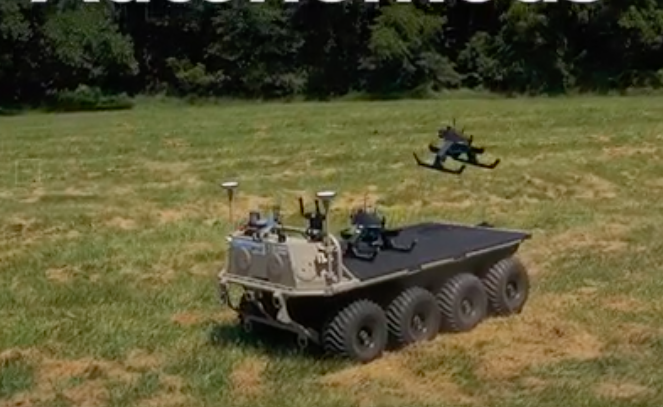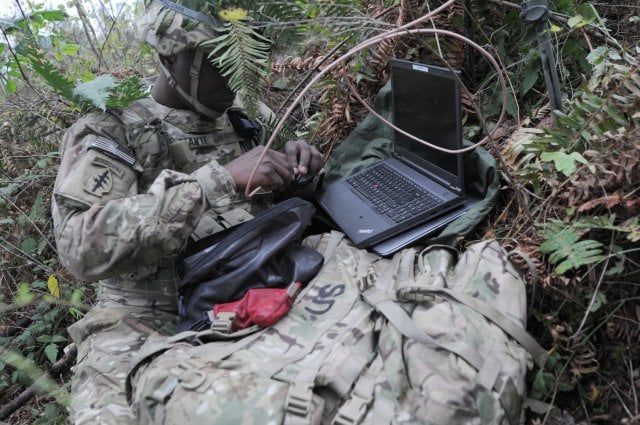By SYDNEY J. FREEDBERG JR.

WASHINGTON: Upcoming experiments at a dozen bases will inform not only how the Pentagon adopts 5G networks on US territory, but how the military modifies civilian 5G tech for battlefield use around the world.
The rapid global spread of 5G networks gives US forces much faster ways to communicate, not only with each other, but with foreign allies — potentially enabling a future international meta-network known as Combined Joint All-Domain Command & Control.
“It’s certainly easier for our allies and partners to get access to 5G equipment — much easier than tactical radio systems,” Joseph Evans, technical director for 5G in the undersecretariat of defense for research & engineering, said.
But operational deployments on foreign soil – let alone to active war zones – raise questions of security, resiliency, and range that civilian-grade 5G may not answer. The solution, Evans said, may be to adopt commercial tech wholesale for use on US bases, but cherry-pick components to incorporate into military tactical networks abroad.
Joseph Evans“Working in the continental US or US [territories], we can certainly use 5G technology pretty much off-the-shelf,” Evans told an ACT-IAC conference this afternoon. “We may want to have specific configurations or use specific protocols…but really, it’s commercial 5G.”
“As we get closer to the tactical edge, and either in parts of the world where the infrastructure is … not necessarily trustworthy… or actually in a contested tactical environment against a peer adversary, that’s where we think that there’s some challenges,” Evans said. “That’s where we have to start looking at … what bits and pieces of 5G we can use.”
“There’s mixes and matches of some of the underlying technologies that we think will be useful in the tactical environment,” he continued. In the pilot projects now getting underway, he said, “we… are exploring, as part of some of these initial efforts, what the limits are and how far we can push to 5G technology to the tactical edge.”

A soldier from the Army’s offensive cyber brigade during an exercise at Fort Lewis, Washington.
The Defense Department has requested $449 million for 5G work in 2021. It has already announced two waves or “tranches” of pilot projects. Enabling 5G networks at US bases was one of the top priorities set by former DoD Undersecretary for Research & Engineering Mike Griffin.
Some $600 million of Tranche 1 awards were announced Oct. 8. That covers one year of setup and two years of experimentation.
The first wave, said Evans, already involves “over three dozen contracts [with] prime contractors [and] over 100 total companies, over half of them non-traditional” – that is, commercial tech companies rather than longstanding defense contractors. At least one more major award is coming soon.
Tranche 1 covers six projects at five bases belonging to four armed services:
Hill Air Force Base: Nokia will build a testbed for five other companies to try out alternative approaches to dynamically sharing spectrum between military radars and 5G communications, two radically different uses. (Historically, radar pulses are so powerful they simply drown out any wireless signals on the same band). Finding a way to share frequencies with civilian users, instead of just handing them over entirely to private firms, is crucial to military operations as civilian demands eat up ever more of the electromagnetic spectrum.
Joint Base Lewis-McChord (Army & Air Force): Four firms will build 5G networks for virtual reality and augmented reality training at both McChord proper and the nearby Yakima training range, which can accommodate a fully Army brigade at a time. Using AR/VR for training, mission planning, and even tactical updates in combat is a major emphasis for Army modernization.
Marine Corps Logistics Base Albany: This pilot will experiment with applying commercial “smart warehouse” systems to heavy Marine Corps vehicles, for example electronically monitoring the maintenance status and “health” of each truck.
Naval Base San Diego: A second smart warehouse initiative, focused on Navy supplies being packaged for delivery to the fleet.
Nellis Air Force Base: Nellis, announced later than the others, will host two experiments, arguably the most ambitious.
One Nellis project seeks to apply 5G technology to the internal networks at a command center, allowing large HQs to downsize and decentralize to multiple, smaller, harder-to-target sites. “You split up a Combined Air Operation Center and disperse it and then make it increasingly nomadic” – i.e. able to relocate – “then potentially increasingly mobile,” i.e. able to function on the move, Evans said. This experiment will use a commercial technology called Cell On Light Truck (COLT), which looks and functions somewhat like a TV news van.
The second Nellis project add various “network enhancements” to the 5G testbed. Evans said the winning contractors for this one would be selected “within the next couple of weeks.”
In June, the Pentagon announced seven more sites, Tranche 2. One of the key goals for the second tranche is to test out spectrum sharing with the private sector; another is incorporating “zero trust” security protocols. Those bases are:
Naval Station Norfolk: 5G networks for both ship-to-pier coordination and internal communication within the ship.
Joint Base Pearl Harbor-Hickam (Navy & Air Force): “aircraft mission readiness.” This probably means digital tracking – and perhaps even predicting – the maintenance needs of each plane.
Joint Base San Antonio (Air Force and Army): Two projects, one “to evaluate augmented reality support of maintenance and training,” the other to “evaluate DOD’s 5G core security experimentation network.”
Tinker Air Force Base: “bidirectional spectrum sharing, both in DOD and the commercial sector.” That sounds like another application of the same kind of technology being tested out at Hill AFB in Utah.
Fort Hood; National Training Center/Fort Irwin; and Marine Corps Base Camp Pendleton: All three sites will explore “wireless connectivity for forward operating bases and tactical operations centers.” That sounds very similar to the work being done at Nellis on shrinking and splitting up HQs. However, here the focus is on frontline tactical units, not on theater command centers. This is an even more challenging environment for the civilian tech.
Formal calls for white-paper proposals have already gone out for the three Navy and Marine Corps sites, Norfolk, Pearl Harbor, and Camp Pendleton. Here, the Pentagon is working with industry through a public-private consortium called the Information Warfare Research Project (IWRP), which held an industry day for interested vendors last month.
The deadline to submit the white papers is still officially Nov. 15, Evans said, but enough companies have requested an extension that “we anticipate extending that … a little further, probably into December.”
Once the government has reviewed the papers, it will use that industry feedback to refine its plans and put out a final solicitation in January or February, Evans said, with contract awards expected in the spring.
Contracts for the remaining four bases – the Army and Air Force sites: San Antonio, Tinker, Ft. Hood, and the NTC at Ft. Irwin – will be awarded through the National Spectrum Consortium. “Hopefully,” said Evans, “we’ll see solicitations there in probably late December or early January.”
No comments:
Post a Comment